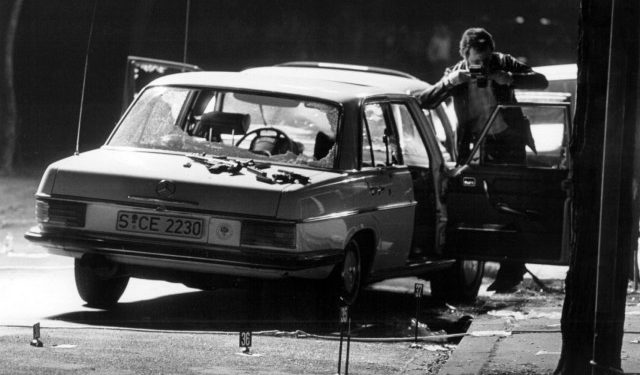Andreas Baader killied a police during a demonstration in Berlin against the visit by the Shah of Iran ın 1967. The activist made it clear that the post-war authorities were little better than that which they had replaced. He started off his campaign in 1968 by detonating home-made bombs in two Frankfurt department stores. Baader was later arrested and imprisoned but had managed to escape in 1970 during a library visit with the help of a left-wing journalist Ulrike Meinhof. The Red Army Faction had been created.
In 1970, several members of the group headed off to Jordan where they were taught how to use a Kalashnikov at a camp run by the Palestinian Liberation Organisation. They spent the next two years carrying out actions in Germany.Baader was soon captured again but with accomplices Jan-Carl Raspe and Holger Meins in a Frankfurt shootout on 1 June 1972.
Baader’s girlfriend Gudrun Ensslin was arrested a week later, and Meinhof was caught in mid-June.
A second generation of militants then took up the fight, carrying out some of the most high-profile attacks in order to secure the release of the fırst group, whose trial was opened in 1975.
That same year the West German embassy in Sweden was seized; two of the hostages, both attaches, were shot dead during the 11-hour siege after Chancellor Helmut Schmidt refused to give in to demands that all the suspects be released.
Later, ın another attempt to free the first group, on 5 September 1977, a woman with a pushchair stepped out in front of a car on a street in Cologne. The driver, who was chauffeuring one of West Germany’s most powerful industrialists, Hanns Martin Schleyer, was forced to brake. The woman pulled out two machine guns, and her accomplices, following behind, bundled Schleyer out of the car. His bodyguards were killed at the scene and one month later.
In the course of the trial, Meinhof was also found hanging from a rope made of towels in her cell. The trial concluded a year later, with the three remaining defendants sentenced to life imprisonment for murder and attempted murder. A new series of assassinations had already begun.
On 7 April 1977, chief public prosecutor Siegfried Buback was killed in Karlsruhe by a motorcycle hit squad. Three months later, the chief executive of Dresdner Bank, Juergen Ponto, was killed at his home in Frankfurt. But it was the September abduction of Schleyer, head of the German Association of Employers and a former member of the Nazi party, which kicked off a series of events known as the “German Autumn”.
THE GERMAN AUTUMN
Schleyer’s captors offered his release in exchange for Baader, Ensslin and nine others. But even as the negotiations were being carried out, Arab sympathisers were finalising a plan to hijack a plane full of German tourists bound to Frankfurt from Majorca to increase the pressure on the authorities.
The aircraft, seized on 13 October, went first to Italy, then Cyprus, Bahrain and Dubai, before finally landing in Mogadishu, where the captain was shot dead by the hijackers. Shortly afterwards, German elite commandos stormed the plane, killing three of the hijackers and freeing the hostages.
Later the Government offıcıals released ın a statement that Baader, Ensslin and Raspe committed suicide – although this was an obivous cover-up by the Government ın attempt to end the RAF.
The next day, Schleyer’s kidnappers announced he had been killed




